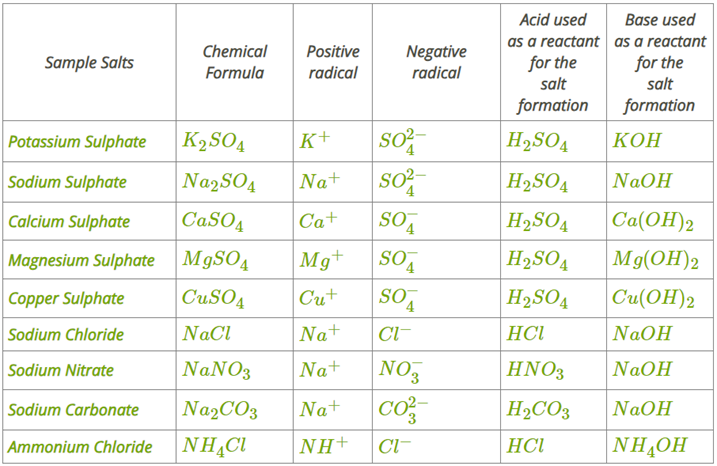
PUMPA - SMART LEARNING
எங்கள் ஆசிரியர்களுடன் 1-ஆன்-1 ஆலோசனை நேரத்தைப் பெறுங்கள். டாப்பர் ஆவதற்கு நாங்கள் பயிற்சி அளிப்போம்
Book Free DemoSalts are the compounds formed by the neutralisation reaction between acids and bases.
Acid + Base \rightarrow Salt + Water
Salts are ionic compounds that dissociate to produce a positively charged ion other than hydrogen H^+ and a negatively charged ion other than hydroxide OH^-. During salt formation, a positive ion is produced by the base, and a negative ion is produced by the acid.
Sodium chloride is the main component of common table salt. The neutralisation of sodium hydroxide NaOH, a base, with hydrogen chloride HCl, an acid, produces sodium chloride (NaCl), and water H_2O :
NaOH + HCl \rightarrow NaCl + H_2O
In the formation of sodium chloride NaCl, the positively charged ion sodium Na^+ comes from sodium hydroxide, and the negatively charged ion chlorine Cl^– comes from hydrochloric acid.
Note:
The most well-known salt is sodium chloride, also known as common salt. It is important to understand that salt is a generic term that does not only refer to sodium chloride.
In fact, sodium chloride is only one member of a large salt family. Other salts include magnesium sulphate, potassium nitrate, calcium carbonate, etc.
Example:
Let us do an activity to identify the family, positive and negative radicals of salts:
Given salt samples:
- Potassium sulphate
- Sodium sulphate
- Calcium sulphate
- Magnesium sulphate
- Copper sulphate
- Sodium chloride
- Sodium nitrate
- Sodium carbonate
- Ammonium chloride

We will now list the different families of salts from the above table:
1. Sodium salts: Sodium sulphate, Sodium chloride, Sodium nitrate, Sodium carbonate.
2. Potassium salts: Potassium sulphate.
3. Magnesium salts: Magnesium sulphate.
4. Ammonium salts: Ammonium chloride.
5. Chloride salts: Ammonium chloride, Sodium chloride.
6. Sulphate salts: Copper sulphate, Magnesium sulphate, Calcium sulphate, Sodium sulphate and Potassium sulphate.
7. Nitrate salts: Sodium nitrate.
8. Calcium salts: Calcium sulphate.
9. Carbonate salts: Sodium carbonate.
From the above table, we conclude the following:
- The family of salts are nothing but the salts having the same negative or positive ions grouped together.
- With the help of positive and negative radicles, we can find the acid and base that is reacted to form the respective salts. The positive radical is dissociated from the base and the negative radical from the acid.
Classification of salts:
1. Acidic salts:
Salt produced by replacing of only a part of the acidic hydrogen in the reaction between a polybasic acid and a metal is known as acidic salts. Thus the anion part of these salts contains one or more hydrogen atoms.
H_2CO_3 + NaOH \rightarrow NaHCO_3 + H_2O
These salts exhibit the properties of salts in an aqueous solution—for example, Sodium bisulphite, Sodium bisulphate, Potassium bisulphite and so on.
2. Normal salts:
Salt produced by replacing of all acidic hydrogen present in acids by a metal or NH_4^+ is known as normal salts. Here the complete neutralisation takes place.
H_2CO_3 + 2NaOH \rightarrow Na2CO_3 + H_2O
The nature of these salts may be acidic, basic or neutral depending on the starting material used—for example, Potassium nitrate, Potassium chloride, Sodium acetate and so on.
3. Basic salts:
Salt formed by incomplete neutralisation of base with an acid or with partial replacement of hydroxyl radicals of diacids or tri-acidic base with an acid radical is known as basic salt—for example, Basic copper nitrate and Lead nitrate.
Cu(OH)_2 + HNO_3 \rightarrow Cu(OH)NO_3 +H_2O
4. Double salt:
It is formed by mixing two simple salts chemically combined together. For example, Mohr's salt, Potash alum.
Here, Mohr's salt is a mixture of FeSO_4 and (NH_4)_2SO_4). Similarly, potash alum is a mixture of K_2SO_4 and Al_2(SO_4)_3.
5. Mixed salts:
Salts that contain two or more acid or basic radicals other than hydrogen and hydroxyl ions are called mixed salts. For example, Sodium potassium sulphate NaKSO_4, Bleaching powder CaOCl_2.
Here in NaKSO_4 - two basic radicals are present Na^+, K^+. Similarly, in CaOCl_2 - two acid radicals are present (OCl^-\), Cl^-.
6. Complex salts:
6. Complex salts:
On dissociation, complex salts give simple and complex ions. For example, potassium mercuric iodide K_2[HgI_4]. Here, the simple ion is K^+ and complex ion is [HgI_{4}]^{2-}.